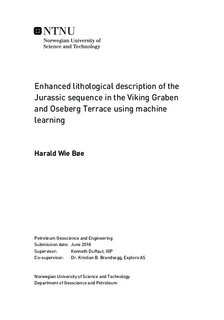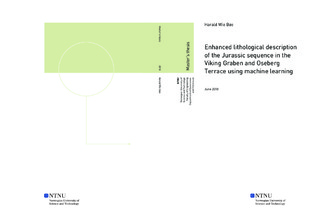| dc.contributor.advisor | Duffaut, Kenneth | |
| dc.contributor.advisor | Brandsegg, Dr. Kristian B. | |
| dc.contributor.author | Bøe, Harald Wie | |
| dc.date.accessioned | 2018-08-10T14:00:37Z | |
| dc.date.available | 2018-08-10T14:00:37Z | |
| dc.date.created | 2018-06-11 | |
| dc.date.issued | 2018 | |
| dc.identifier | ntnudaim:19809 | |
| dc.identifier.uri | http://hdl.handle.net/11250/2557605 | |
| dc.description.abstract | Automatic classifications of well logs using machine learning techniques has gained improved attention within the last couple of years among others for increasing the accuracy and speed of lithofacies prediction on wireline logs. A supervised machine learning methodology written in R combines initial wireline log signatures and computer assisted interpretations (CPI s) to automatize lithofacies predictions. The method utilizes the XGBoost algorithm, a gradient boosting library with emphasis on computational speed and model accuracy. The study area is the Jurassic sequence of the prolific quadrant 30 in the Norwegian Northern North Sea, with 26 available wells that consists of wells from structural Highs, Grabens and Terraces.
Raw well log data are preprocessed in order to obtain a consistent database and the well log signatures from all 26 wells are analyzed concurrently with the use of boxplots. Seven different lithoclasses are generated based on the CPI's which are used as training data and validation data. Three different machine learning models (initial, normalized and enhanced) are created and optimalized. The initial model is created using only the raw logs without modifications and the normalized model is created using standardized logs. The enhanced model is created with several features and modifications added to increase prediction accuracy. The models are applied to 11 wells and key differences between the models in terms of accuracy are presented.
The results show that the initial model provides a decent baseline accuracy while the normalized model shows signs of underfitting. The enhanced model shows great promise in accuracy. The number of well logs available within a well has a direct influence on the accuracy of the models. For an acceptable predicting power the wells should minimum contain the gamma ray, density and neutron logs. To distinguish between water-bearing and hydrocarbon bearing zones in sandstones the resistivity logs should be present. The choice of petrophysical filters when creating the lithoclasses has potential and will have more predicting power with improved refinement according to the aim of the study. When implemented on a larger scale caution need to be taken when introducing more geologic complexity in the input data.
Machine Learning shows good promise in assessing wireline logs and the ML design in terms of training data should account for lateral variations such as depositional environment and varying burial depth to achieve optimal prediction accuracy. | |
| dc.language | eng | |
| dc.publisher | NTNU | |
| dc.subject | Petroleumsfag, Petroleumsgeofysikk | |
| dc.title | Enhanced lithological description of the Jurassic sequence in the Viking Graben and Oseberg Terrace using machine learning | |
| dc.type | Master thesis | |

